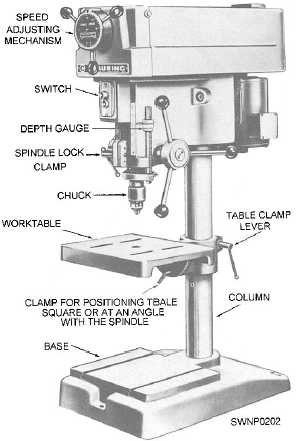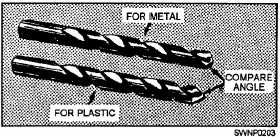
Figure 12-16. - Radial drill press.
After operating a drill press, wipe off all dirt, oil, and metal particles. Inspect the V-belt to make sure no metal chips are embedded in the driving surfaces.
DRILL BITS
Common drill bits are known as TWIST DRILLS because most of them are made by forging or milling rough flutes and then twisting them to a spiral configuration. After twisting, the drill bits are milled to the desired size and heat-treated.
The general-purpose twist drill is made of high- speed steel. Figure 12-17 shows a typical plastic-cutting drill bit and a typical metal-cutting drill bit. Notice the smaller angle on the drill bit used for drilling plastics.
Drill bit sizes are indicated in three ways: by inches, by letter, and by number. The nominal inch sizes run from 1/16 inch to 4 inches or larger. The letter sizes run from "A" to "Z" (0.234 inch to 0.413 inch).

Figure 12-17. - Comparison of a twist drill for plastic and a twist drill for metal.
The number sizes run from No. 80 to No. 1 (0.0135 inch to 0.228 inch).
Before putting a drill bit away, wipe it clean and then give it a light coating of oil. Do not leave drill bits in a place where they maybe dropped or where heavy objects may fall on them. Do not place drill bits where they will rub against each other.
A drill bit should be reground at the first sign of dullness. The increased load that dullness imposes on the cutting edges may cause a drill bit to break.
Cutting Fluids
When drilling steel and wrought iron, use a cutting oil. Cast iron, aluminum brass, and other metals may be drilled dry; therefore, at high-drilling speeds it is advisable to use some medium for cooling these metals to lessen the chances of overheating the drill bit with the resultant loss of the cutting edge. Compressed air may be used for cast iron; kerosene for aluminum; oleic acid for cooper; sulphurized mineral oil for Monel metal; and water, lard, or soluble oil and soda water for ferrous metals. (Soda water reduces heat, overcomes rust, and improves the finish.)
Sharpening Drill Bits
A drill bit becomes dull with use and must be resharpened. Continued use of a dull drill bit may cause it to break or bum up as it is forced into the metal. Improper sharpening will cause the same difficulties.
Remove the entire point if it is badly worn or if the margins are burned or worn off near the point. If, by accident, the drill bit becomes overheated during grinding, do NOT plunge it into the water to cool. Allow it to cool in still air. The shock of sudden cooling may cause it to crack.
Continue Reading